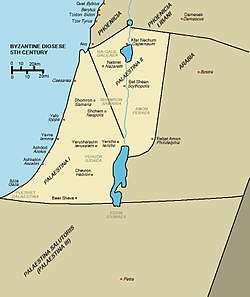Palaestina Prima
Palæstina Prima or Palaestina I was a Byzantine province from 390,[1] until the 7th century. It was lost to the Sassanid Empire in 614, but was re-annexed in 628, before its final loss during the Muslim conquest of Syria in 636.
| Provincia Palaestina Prima ἐπαρχία Πρώτη Παλαιστίνης | |||||||||
|---|---|---|---|---|---|---|---|---|---|
| Province of the Diocese of the East (Byzantine Empire) | |||||||||
| 390–636 | |||||||||
 Byzantine provinces in the 5th century | |||||||||
| Capital | Caesarea Maritima | ||||||||
| Historical era | Late Antiquity | ||||||||
• division of the Roman Empire | 390 | ||||||||
• Samaritan Revolts | 484–572 | ||||||||
• Persian occupation and Jewish revolt | 614–628 | ||||||||
• Muslim conquest of Syria | 636 | ||||||||
| |||||||||
| Today part of | |||||||||
Part of a series on the |
|---|
| History of Israel |
 |
| Ancient Israel and Judah |
| Second Temple period (530 BCE–70 CE) |
| Late Classic (70-636) |
| Middle Ages (636–1517) |
| Modern history (1517–1948) |
| State of Israel (1948–present) |
| History of the Land of Israel by topic |
| Related |
|
|
History
The area became organized under late Roman Empire as part of the Diocese of the East in which it was included, together with the provinces of Isauria, Cilicia, Cyprus (until 536), Euphratensis, Mesopotamia, Osroene, Phoenice and Arabia Petraea. Under Byzantium, a new subdivision further split the province of Cilicia into Cilicia Prima, Cilicia Secunda; In 6th century, Syria Palaestina was split into Syria Prima, Syria Salutaris, Phoenice Lebanensis, Palaestina Prima, Palaestina Secunda and eventually also Palaestina Salutaris.
Despite Christian domination, until the 4th and 5th centuries Samaritans developed some autonomy in the hill country of Samaria, a move that gradually escalated into a series of open revolts. The four major Samaritan Revolts during that period caused a near extinction of the Samaritan community as well as significant Christian losses. In the late 6th century, Byzantines and their Christian Ghassanid allies took a clear upper hand in the struggle.
In 614, Palaestina Prima and Palaestina Secunda were conquered by a joint Sassanid and Jewish army. The event shocked the Christian society, as many of its churches were destroyed and the True Cross taken by the Persians to Ctesiphon. After withdrawal of the Persian troops and the subsequent surrender of the local Jewish rebels, the area was re-annexed by Byzantium in 628.[2]
Byzantine control of the province was again and irreversibly lost in 636, during the Muslim conquest of Syria.
Demographics
The province of Palaestina Prima included a mixed Greek and Aramaic-speaking population, with Greek and Roman Christians forming one of its largest demographic groups. Samaritans were the second dominant group, which populated most of the hill country of Samaria, numbering around one million in the 4th and 5th centuries. Minorities of Jews, Christian Ghassanids and Nabateans were present as well. Jews formed a majority in the neighbouring Palaestina Secunda (the Galilee), while the Ghassanids and Nabateans inhabited the Arabian desert to the south and east. Most of the Jews of prior Antiquity, however, had been exiled to Babylon after wars with the Romans, leading to the creation of the Pharisaical Babylonian Talmud.
Depending on the time, either a notable Roman or Persian military presence would be noted.
Religion
During the Byzantine period, Palestina Prima gradually became a center of Christianity, attracting numerous monks and religious scholars from the Near East and Southern Europe, and abandoning previous Roman and Hellenistic cults. Arianism and other forms of Christianity found themselves in a hostile environment as well.
Variants of the Mosaic religion were still at large from the 4th until the 6th centuries, practiced by ethnoreligious communities of Samaritans and Jews. However, with the decline of the Samaritan and Jewish populations through war and by conversion during the 6th and 7th century, the religion declined as well. By the late Byzantine period, fewer synagogues could be found and many were destroyed in violent events. The city of Hebron is notable in being one of the last Jewish cities remaining (although the Cave of the Patriarchs had been converted into a Church).
See also
- Palaestina Secunda
- Palestina Salutaris
- Coele-Syria
- Iudaea Province
References
- Lehmann, Clayton Miles (Summer 1998). "Palestine: History: 135–337: Syria Palaestina and the Tetrarchy". The On-line Encyclopedia of the Roman Provinces. University of South Dakota. Archived from the original on 2009-08-11. Retrieved 2014-08-24.
- Geoffrey Greatrex, Samuel N. C. Lieu (2002), The Roman Eastern Frontier and the Persian Wars: AD 363-628, p. 196.
Sources
- Shahîd, Irfan (1995). Byzantium and the Arabs in the Sixth Century, Volume 1. Washington, DC: Dumbarton Oaks. ISBN 978-0-88-402214-5.CS1 maint: ref=harv (link)